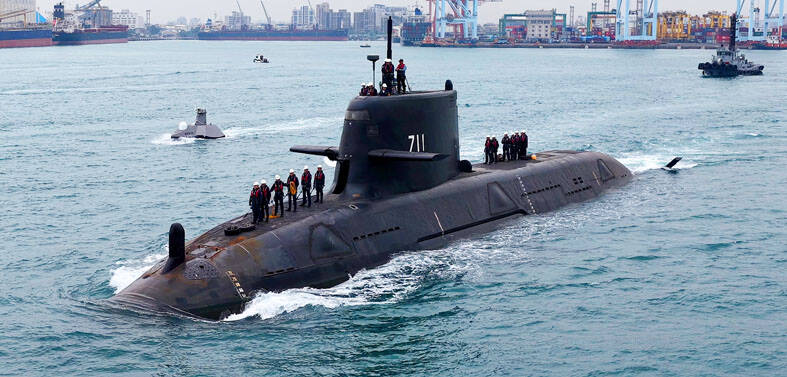Taiwan’s two combat-capable submarines will be equipped with anti-ship missiles next year, providing the nation’s undersea force with a long-distance strike capability it had previously lacked.
The Chinese-language United Daily News reported on Wednesday that more than 30 US-built surface-to-surface Harpoon cruise missiles would become operational on the two Hailung-class submarines sometime next year. The subsonic sea-skimming missiles, which have a range of about 125km, will bring targets along the Chinese coast within range.
The navy recently test-fired the weapons in the US in preparation for their installation on the Dutch-built submarines, the report said, citing unnamed navy sources.

Photo: Chang Chia-ming, Taipei Times
A US$6.4 billion arms sale notification to US Congress in October 2008 included 32 UGM-84L sub-launched Harpoon Block II missiles, plus two UTM-84L exercise missiles and two weapon control systems for Taiwan.
The US Department of Defense awarded a US$43.85 million defense contract to Boeing for the production and procurement of 32 Harpoon missiles for Taiwan in June 2010, with work to be completed in June last year.
The navy has declined to comment on the report, citing a policy of not discussing arms purchases with the media. Taiwan’s frigates and F-16 aircraft are already armed with Harpoon missiles.
However, integrating the Harpoon missiles requires substantial modifications to existing fire control systems and launch tubes and some defense analysts have been skeptical as to whether the Hailungs could accommodate them. Reports last year that indigenously made Hsiung Feng II cruise missiles had been test-launched on the subs were discredited soon afterwards.
However, the latest news is far more credible. The navy first announced its intention to modify the submarines so they could fire Harpoon missiles back in 2005.
Approached for comment, a retired navy officer told the Taipei Times yesterday that the project was entirely feasible.
A standalone fire control system that does not interfere with existing combat systems must be developed, the source said, adding that while it was possible to have the Harpoon fire control system integrated to current systems, doing so would require complicated engineering modification work.
In addition to the fire control systems, adjustments to the torpedo tube mechanism could be necessary to accommodate the launch of both torpedoes and the Harpoon missiles, the source said.
Another option would be to add a standalone launch tube for the Harpoons, he said.
US firm Boeing Co, which was the main contractor for the project, sent experts to Taiwan to assist the navy complete the necessary modifications on the submarines.
Additional work may also have been carried out by Raytheon Corp.

US climber Alex Honnold is to attempt to scale Taipei 101 without a rope and harness in a live Netflix special on Jan. 24, the streaming platform announced on Wednesday. Accounting for the time difference, the two-hour broadcast of Honnold’s climb, called Skyscraper Live, is to air on Jan. 23 in the US, Netflix said in a statement. Honnold, 40, was the first person ever to free solo climb the 900m El Capitan rock formation in Yosemite National Park — a feat that was recorded and later made into the 2018 documentary film Free Solo. Netflix previewed Skyscraper Live in October, after videos

NUMBERS IMBALANCE: More than 4 million Taiwanese have visited China this year, while only about half a million Chinese have visited here Beijing has yet to respond to Taiwan’s requests for negotiation over matters related to the recovery of cross-strait tourism, the Tourism Administration said yesterday. Taiwan’s tourism authority issued the statement after Chinese-language daily the China Times reported yesterday that the government’s policy of banning group tours to China does not stop Taiwanese from visiting the country. As of October, more than 4.2 million had traveled to China this year, exceeding last year. Beijing estimated the number of Taiwanese tourists in China could reach 4.5 million this year. By contrast, only 500,000 Chinese tourists are expected in Taiwan, the report said. The report

Temperatures are forecast to drop steadily as a continental cold air mass moves across Taiwan, with some areas also likely to see heavy rainfall, the Central Weather Administration (CWA) said. From today through early tomorrow, a cold air mass would keep temperatures low across central and northern Taiwan, and the eastern half of Taiwan proper, with isolated brief showers forecast along Keelung’s north coast, Taipei and New Taipei City’s mountainous areas and eastern Taiwan, it said. Lows of 11°C to 15°C are forecast in central and northern Taiwan, Yilan County, and the outlying Kinmen and Lienchiang (Matsu) counties, and 14°C to 17°C

STEERING FAILURE: The first boat of its class is experiencing teething issues as it readies for acceptance by the navy, according to a recent story about rudder failure The Hai Kun (海鯤), the nation’s first locally built submarine, allegedly suffered a total failure of stern hydraulic systems during the second round of sea acceptance trials on June 26, and sailors were forced to manually operate the X-rudder to turn the submarine and return to port, news Web site Mirror Daily reported yesterday. The report said that tugboats following the Hai Kun assisted the submarine in avoiding collisions with other ships due to the X-rudder malfunctioning. At the time of the report, the submarine had completed its trials and was scheduled to begin diving and surfacing tests in shallow areas. The X-rudder,